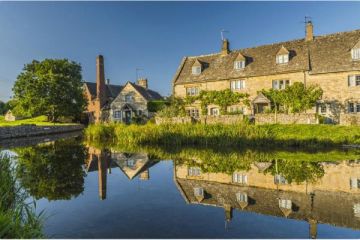CONTENT
1. UK Destinations
2. Stone Age Temple in Wales
3. Country Houses Database
4. Cawdor Castle Online
5. New Books on Britain
6. UK Travel news
Welcome friends, its time to put the kettle on, settle into a comfortable armchair, and enjoy the best of Britain with Britain Update. But before you do, please take the time to forward this newsletter to someone who loves Britain as much as you do.
David Ross, Publisher
********************
UK Destinations : Old Sarum
********************
The cathedral city of Salisbury is justifiably popular as a tourist destination. It's an attractive city, with a number of intriguing older buildings in addition to the lovely Cathedral itself. But just a few miles up the road towards Stonehenge lies Old Sarum, the original site of Salisbury.
Old Sarum is approached via an opening in two high Iron Age banks, which obscure the site from outside, and give it the air of a mysterious hidden castle. The banks were begun almost 5000 years ago, and remained intact until the Roman invasion. The Romans installed a garrison in the river valley below the site and it was probably used as a market centre. At this time it was called Sorviodunum.
Read more: /Where_to_go_in_Britain/Destination_Library/old-sarum.htm
******************************
Stone Age Temple Revealed in Wales
******************************
A report in the Sunday Independent newspaper reveals that archaeologists have discovered the largest Stone Age structure in Europe at a site near New Radnor, Powys.
The temple was composed of over 1,400 obelisks made of oak, each rising to a height of 23 feet. The oak posts are arranged in an oval shape covering over 85 acres. Within the site is a natural spring - perhaps venerated as a sacred site. The main entrance to the site seems to be oriented towards the position of the setting sun at the summer solstice. To get a sense of the amazing size of the temple, consider that it measures 30 times as large as Stonehenge
The New Radnor site has not been conclusively dated yet, but was probably begun no later than 2700 BCE, and possibly as early as 4000 BCE. It was kept cleared for almost 3000 years until the Roman occupation, which indicates an extraordinarily long period of use as an important religious or ceremonial centre.
******************
New: Country House Database
******************
In the last issue of Britain Update, I mentioned the DiCamillo Companion to Country Houses in Great Britain and Ireland, (http://www.dicamillocompanion.com ) a wonderful database of information on over 6000 historic UK properties. Now with the co-operation of Curt DiCamillo you can search the Companion database directly from Britain Express. The database search form is located here.
****************************
UK Online
****************************
14th century Cawdor Castle, made famous in the William Shakespeare play, Macbeth, is now online. The new site is at http://www.cawdorcastle.com, and it was worth the wait. The site is very attractively laid out, with separate sections focussing on the history of the Macbeth legend, the castle gardens, and visitor information, with a rudimentary virtual tour of the castle interior.
******************************
UK Travel Tips and News
******************************
HAMPTON COURT PALACE COMES ALIVE WITH SPRING FLOWERS
Tip toe through the tulips at Hampton Court Palace as the Queen's State Apartments come alive with the sights and smells of fruits and flower. From March 23-27, guests will view decorative displays of vanitas or the portrayal of life's journey artistically arranged in unique gatherings of flowers, fruit, books, candles, insects and skulls. Mary II, wife of William of Orange, introduced many of the types of flowers take for granted today. Perhaps the pioneer of the English garden, she also collected Delftware porcelain nine-tier tulip vases which artfully showcased her collection of exotic flowers and shrubs.
The National Association of Flower Arranging Societies will delight and inform audiences with daily demonstrations of period flower arrangements. The weekend will also be full of workshops, tours and presentations. The most noted presentation will be life at the court of William III and Mary II as demonstrated by costumed guides in the Queen's Gallery. Other activities include a workshop on the art of assembling small, hand-held bouquets with flowers and herbs perfect for any occasion.
The admission prices are approximately $15.75 for adults and $10.50 for children. A family ticket (2 adults and 3 children) is approximately $47.10. The hours in March are 9:30 a.m. to 4:30 p.m. except on Mondays when the Palace opens at 10:15 a.m
BLUE PLAQUE HONOURS JOHN LENNON
On 8th December 2000, John Lennon became the first British rock musician to be honoured with an English Heritage blue plaque in recognition of his unique contribution to popular music and his undisputed status as an icon of the twentieth century.
The plaque was erected on Lennon's childhood home 'Mendips', 251, Menlove Avenue, Woolton, Liverpool. Lennon lived at Mendips - a late 1930s semi-detached house typical of the suburbs of Woolton - with his Aunt Mimi, the elder sister of his mother Julia, between 1945 and 1964. The plaque was unveiled by Stanley Parkes, Lennon's cousin.
That's all for now. Until next issue, let me remind you that laughter is contagious. Be a carrier.
David Ross, Publisher, Britain Express




